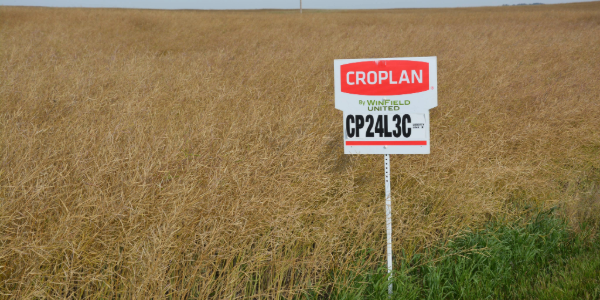The hard part of seeding is done, and now it’s time to sit back, relax, and watch your crop grow, right? Oh, if only it were that easy! There’s no rest during farming season, and scouting remains a top priority – leading right into one of the most important agronomic decisions during the growing season: herbicide management for reduced resistance risk.
Just how big of a risk is herbicide resistance on the Prairies? The chart below, updated as of November 2023, shows herbicide resistance weeds that have been found on the prairies:

Source: https://www.prairieweeds.com/
With over 25 weed species listed, it’s clear that herbicide resistance isn’t just limited to a few troublemakers – it's spread across many of the usual weed suspects on the Prairies. Dr. Charles Geddes, a researcher with Agriculture and Agri-Food Canada, estimates that herbicide resistance weeds cost prairie farmers $658 million annually1. With costs like this, working to prevent herbicide resistance needs to be top of mind.
Nobody wants herbicide resistant weeds crashing their field party, but without management, they’ll show up as an uninvited guest. The good news is that there are some proactive strategies that can be taken for preventing herbicide resistance:
- Like nutrient management, similar rules can be applied like the 4R program. Follow the 4R’s – right rate, applied in the right place, at the right time, using the right source.
- Use multi-mode of action products.
- Scout early and often to control weeds while they’re small.
- Rotate herbicide groups.
1. Follow the 4R's:
Right Rate: Herbicides should always be used at the label rate and not stretched to fit a tank. Where there is multiple label rates provided, the appropriate rate should be used for the weed spectrum and staging you’re trying to kill. Be mindful as well that when growing conditions are suboptimal, weeds may remain small but be more advanced than is on label. Small doesn’t equal immature.
Right Place: Make sure your weeds are hitting your target. If using a contact herbicide, water volume is critical for success. Droplet size matters – ensure you know whether you should have a coarse or medium droplet etc. Drift control products, like StrikeLock™ or MasterLock®, can help keep your spray on target. Pay attention to wind speeds, boom height, and sprayer speed to make sure your droplet goes where it should.
Right Time: Certain herbicides are more affected than others by environmental factors such as humidity and sunlight. Glufosinate, for instance, performs best when applied in sunny, high humidity conditions. Conversely, diquat translocates best under dark conditions and should therefore be applied in the evening for maximum movement throughout the plant prior to being activated by sunlight.
Also, similar to the point below, ensure that herbicides are applied at the right time (stage) when weeds are susceptible and will be controlled by the herbicide.
Right Source: Ensure the herbicide you’re using is effective for the weeds you’re killing and at the stage they’re at. If you have known ‘fop’ resistant wild oats, then using clodinafop is not the right source despite it being labelled.
It’s also important to take a look at what is going in your tank mix and ensure that the source you’re using isn’t tied up by anything else in the tank. Have you tested your water? Many herbicides are negatively affected by hard water.
Adding a water conditioner, such as Crimson® NG, can reduce effects seen from antagonism due to poor water quality. Similarly, many herbicides require the addition of a non-ionic surfactant (NIS) or methylated seed oil (MSO) to penetrate hairy or waxy leaf surfaces. Ensuring that the appropriate adjuvant is used is key to making sure the right herbicide is being properly applied and can get into the plant as intended.
2. Use multi-mode of action products:
Weeds that have multiple modes of action acting upon them are more likely to get killed by at least one of the modes, even if they’re resistant to the other, thereby preventing the spread of resistant seed.
“Anytime we’re mixing herbicides up and using products with multiple modes of action, it will help mitigate resistance,” says Lyle Jensen, Lead Agronomist at AgroPlus in Lethbridge, Alberta.
As a secondary benefit, some herbicides act synergistically together, creating an effect where they are hotter on weeds together than either would be individually. Think of many Group 6 and Group 27 herbicide products. The combination of bromoxynil with many Group 27’s creates a situation where 1 + 1 = 3.2
A word of caution - any time two or more chemistries are combined, there is a high likelihood of either a synergistic or antagonistic relationship, and this is why following label recommendations is critical. However, even if a mix has an antagonistic relationship, it doesn’t mean it cannot be used. It might be useable but require an additive to address the antagonism to achieve an effective application. This situation is commonly seen with Imazamox and Bentazon, where a nitrogen source is required to overcome the grass control antagonism that will otherwise result. Always read the label.
3. Scout early and often:
Weeds are most susceptible to herbicide while they’re at an earlier stage. Plus, early and effective herbicide application means that they will be controlled prior to setting seed and further propagating throughout your field for the next generation. By scouting early in the season, you’ll have the right information to make a choice on when to spray, and with what chemistry for the weeds that exist on your farm.
4. Rotation of herbicide groups:
Herbicides become resistant due to weeds surviving past applications and setting seed. This process repeats over generations until the population of resistant weeds in a field eventually becomes greater than the population of susceptible weeds. Rotating herbicide groups each year can help slow down this trend.
Think of it as a viral dance trend on TikTok:
In year one, a few teens post it with barely any views.
Year two, influencers catch on and it shows up as recommended content on your feed.
By year three, celebrities are doing it on late-night shows, your grandma is busting it out at weddings, and it’s featured in a Superbowl ad.
If the dance trend doesn’t get killed off by the influencers, it propagates and grows. Weeds are no different – they’re doing everything they can to go viral in your fields. Herbicide resistance is a growing concern, and the best way to stop the spread is by switching up your herbicide groups and staying one step ahead.
Product Options
Once you’ve assessed what weeds are present on your farm - and which ones you don’t want crashing your crop party – and figured out the timing for your herbicide application, you can decide what product to use. There is no shortage of offerings, but we’re going to look at three cereal products of interest:
Oxbow®Oxbow, launched by Nufarm in 2024, tackles broadleaf control in wheat, durum, and barley. Featuring two modes of action from groups 4 and 6, it quickly won favour with growers for its efficacy, along with re-cropping and application flexibility.
“Given the strong pulse area we’re in, Group 27 products have been a challenge from a rotation standpoint,” says Scott Lindsay, Manager of CORE Ag Inputs – Warner located in Alberta. “That’s why it’s great to have Oxbow as an option, and the crop safety has been particularly good.”
Oxbow features a wide window of application from 3-leaf to flag, and will control Groups 2,4,9, and 14 resistant kochia.
“On dryland fields, there was less green kochia in the crop at harvest time, which made for a smoother harvest,” shares Jensen with AgroPlus. “Both the 30 acre/jug (high rate) and the 40 acre/jug (low rate) options worked well. The control was better than any other product that we have used in recent years.”
OnDeck™
Originally developed for brown soil zones, Corteva’s OnDeck is now available across the Prairies. It quickly drew attention for being a Group 6 and Group 27 product that delivers broad-spectrum weed control without having re-cropping restrictions on major crops.
“The combination of Group 6 and Group 27 in OnDeck, without concerns about rotational issues, is a huge reason to use it,” says Les Olafson, Customer Account Specialist with ProSoils Inc. located in Saskatchewan.
Fellow advocate Lloyd Van Eeden Petersman, Lead Agronomist with Taber Home & Farm Centre located in southern Alberta, highlights OnDeck’s value in herbicide resistance strategies. “OnDeck is a good fit for resistance management by offering a Group 6 and 27. These aren’t necessarily new groups within the four-year rotation but offers another safe product to fit in this space.”
OnDeck also has a label additive of an HSOC or MSO (such as StrikeLock or Journey® HSOC) for control of tough-to-kill broadleaves like common mallow and common ragweed. As mentioned above about the right source, ensuring additives are used when required is vital for maximum efficacy.
Cazado™
“Herbicide resistance is a very big concern in our region, particularly with widespread Group 1 and Group 2 resistant wild oats,” says Jensen. To address this challenge, ADAMA’s latest innovation, Cazado, provides another tool in the fight against herbicide resistant grassy weeds.
Cazado is the first product available in Canada that offers a combination of a full-rate Group 1 (pinoxaden) and Group 2 (thiencarbazone) product together. With a wide range of broadleaf tank-mix options on its label, Cazado will be a solid fit on wheat and durum acres across the prairies this season.
Keep Weeds Off the Guest List
Herbicide resistance might not wear a name tag, but it’s already crashing the party on many Prairie farms—and it’s costing more than just frustration and bad vibes. The good news? You’ve got the tools and know-how to show it the door. By following the “Herbicide 4R’s”, scouting early and often, leaning on multi-mode of action products, and rotating herbicide groups, you’re not just managing resistance - you’re setting your crop up for success and keeping resistance at bay with a more strategic crop protection party. With options like Oxbow, OnDeck, and Cazado in your rotation, you’re not just fighting weeds—you’re farming smarter.
So, while it’s not quite time to sit back and relax, with a solid plan in place, you can keep unwelcome weeds off the dance floor and farm forward with confidence.
1. Source: WinField United Canada Webinar Series #5, Herbicide Resistance, Mar 4/25
2. https://awsjournal.org/wp-content/uploads/articles_xml/2675-9462-aws-40-spe1-e020220051/2675-9462-aws-40-spe1-e020220051.pdf



